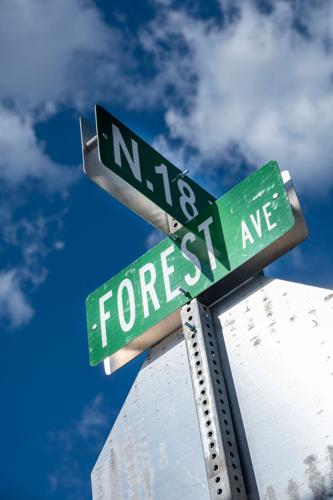
Erin Kice (left) and Keri Adams
Street View is a monthly column in which we take a close look at development-related issues affecting different neighborhoods throughout the city.
On Sept. 11, Tennessee Department of Transportation crews replaced the sign on Forest Avenue in East Nashville. For years, the street had been named “Forrest Avenue,” but this year the Metro Council voted to change the spelling to “Forest” after a number of residents petitioned for a change.
The primary reason for the change seemed obvious to many: At first glance, the name Forrest evokes Confederate general and KKK leader Nathan Bedford Forrest.
Tennessee has numerous monuments to Forrest, and activist efforts in recent years have led to the removal of Forrest monuments and new names for streets and parks. In June 2021, Tennessee officials removed a bust of Forrest from the state Capitol after years of protests. Later in 2021, an infamous Forrest statue on private property facing I-65 was removed by the property’s new owners. In recent years, Memphis has also made changes: The city removed its Forrest monument, renamed its own Forrest Avenue and relocated Forrest’s remains to Columbia, Tenn.
Renaming streets in Tennessee can be an arduous process because of the Heritage Protection Act, which prohibits removing monuments or renaming places with any demonstrable ties to historical figures, unless groups obtain a waiver from the Tennessee Historical Commission. The act was enacted in 2013 after Memphis moved to rename a number of Confederate spaces. Shortly after the legislation was passed, the group Sons of Confederate Veterans issued a press release taking credit for its “basic text.” (The bill’s sponsor later denied this, though he did admit the SCV had input in the bill’s process.)
The Heritage Protection Act considerably lengthened the process for removing monuments like the Nathan Bedford Forrest statue from the Tennessee State Capitol. But for East Nashville’s then-Forrest Avenue, neighbors had an advantage: The street likely wasn’t named after Nathan Bedford Forrest at all.
Erin Kice is one of the neighbors who organized to rename the street. Kice says she first became interested in the street’s history after seeing early-20th-century maps of the neighborhood with the single-R spelling.
“The more we looked into it, the more it seemed like it was named Forest with one R based on the other street names around here,” says Kice. Forest Avenue is near other arboreally themed streets like Woodland and Holly streets, and historically bordered a woodland area.
East Nashville neighbors had approached District 6’s then-Councilmember Brett Withers a number of times about changing the name, but efforts had repeatedly lost traction. Constituents were particularly passionate in 2020, but Withers cautioned against going door to door because of social distancing concerns.
But this year, the timing worked out: During the name change’s public comment process, Metro’s Planning Commission received about 75 notes in favor of the change and about 20 notes in opposition. Name-change advocates living in multiple sections of the street knocked on doors and left petitions on porches.
“It was truly a grassroots, neighbor-to-neighbor conversation,” says Keri Adams, who knocked on doors, created a petition for her section of the street and gathered letters of support. “I was surprised by how many people said, ‘This has bothered me since I moved here.’”
As part of the name-change process, the Metro Historical Commission researched the street’s history. The commission’s report found no link between the street spelling and the Confederate general. The street had been named Forest Avenue in documents as early as 1887, and historical maps had the street spelling with both one R and two.

Subdivision of the A.V.S. Lindsley 29-Acre Tract, 1887
On June 22, the Metro Planning Commission held a public hearing about the name change. Most of the public comments were in favor; some speakers mentioned that despite the name’s history, most people reading the sign would likely perceive an association with Nathan Bedford Forrest. Speakers opposing the change cited concerns over mail delivery and emergency services, but Withers explained that because the two names were so similar, disruption would likely be minimal.
Withers’ legislation passed through the council unanimously, and the name change became official in August — right at the end of Withers’ second and final term.
“It’s been one of those lingering topics in East Nashville for a long time,” Withers tells the Scene. “I’m grateful to have that done.”

The new name coincided with a conservation easement for a green space at the terminus of the street, a four-acre parcel that Withers and his constituents helped the city acquire.
“Those two things happened at the same time — we got the street renamed to Forest with one R, and it terminates at an actual forest that we’re going to preserve,” says Withers. “So I think that’s a really nice wrap-up to my council term.”
At the Planning Commission meeting, perhaps the most compelling testimony came from Jeremy Lindsay, who said he was speaking for his wife Allison and next-door neighbor Monique, who are both Black. “I think the people that are opposed to this, if they knew Allison, and they knew Monique, and they could make them feel a little more comfortable, it would be a pretty easy call,” said Lindsay. “It’s one R. It feels like a pretty small ask, and it’ll make people feel a lot more welcome.”
In a letter to the commission, one resident put it less gently.
“I don’t want to live on a street that is named after a Confederate loser,” wrote 11-year-old Molly Geiss. “Please change our street to be Forest with one R.”







